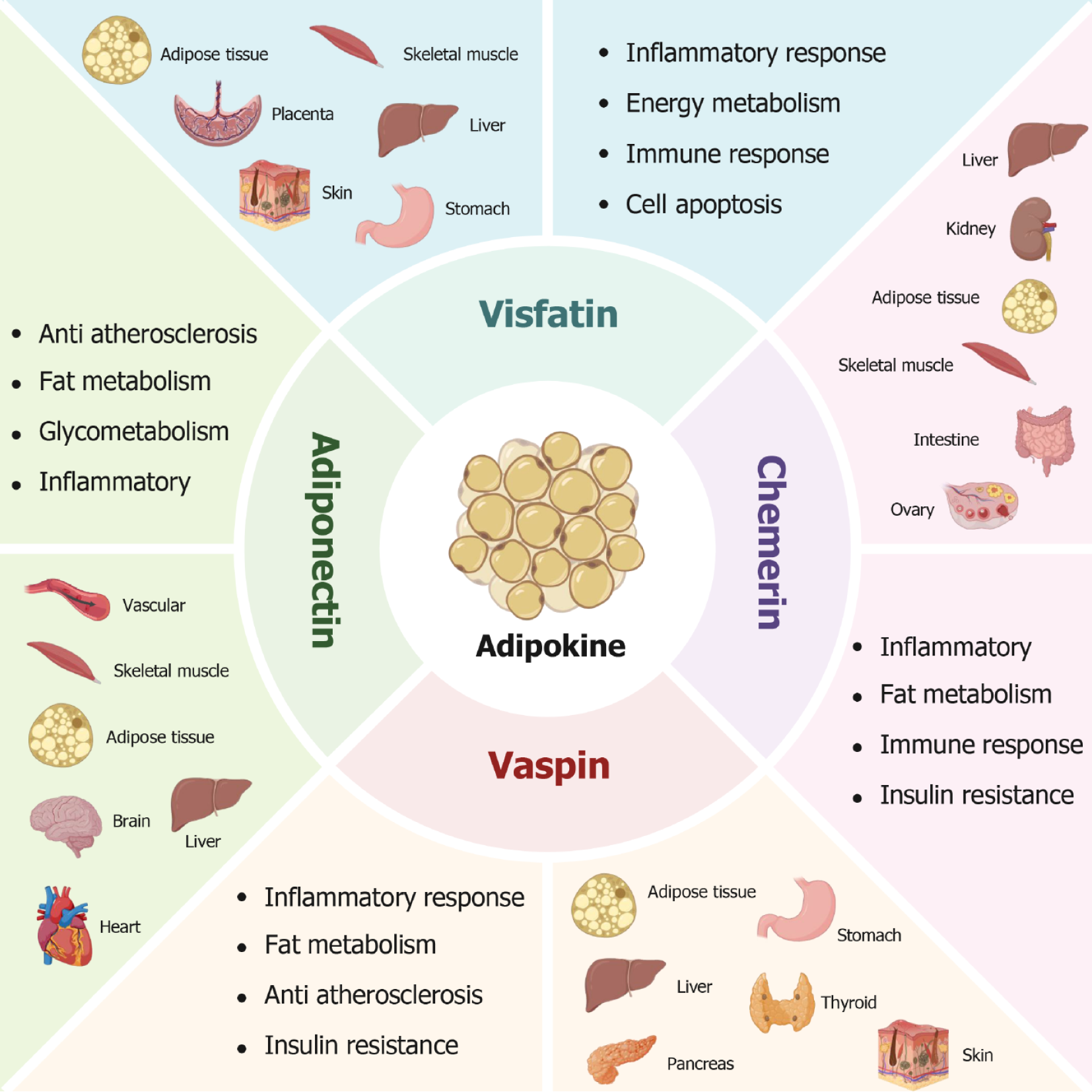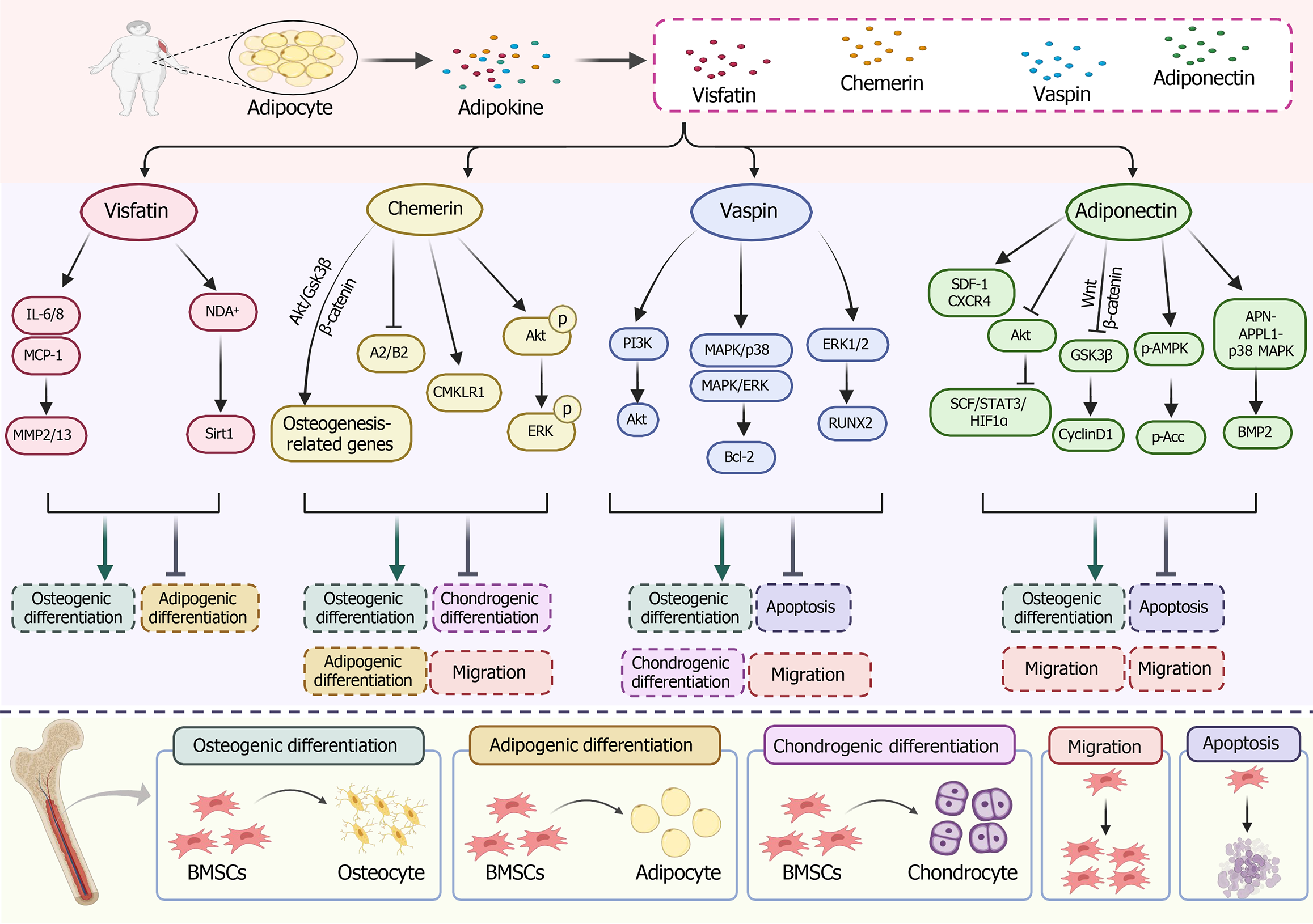Copyright
©The Author(s) 2025.
World J Stem Cells. May 26, 2025; 17(5): 106150
Published online May 26, 2025. doi: 10.4252/wjsc.v17.i5.106150
Published online May 26, 2025. doi: 10.4252/wjsc.v17.i5.106150
Figure 1 The distribution and biological roles of four adipokines (visfatin, chemerin, vaspin, and adiponectin) in human tissues and organs.
Visfatin primarily comes from visceral adipose tissue, but it is also expressed in placenta, skin, liver, stomach and hypothalamus, and plays an important role in regulating energy metabolism, inflammatory reaction, apoptosis and immune response. Chemerin is mainly secreted by adipocytes, macrophages, dendritic cells and endothelial cells, showing multiple biological effects, such as regulating adipocyte differentiation, participating in immune response, and promoting cholesterol uptake by macrophages. Vaspin is composed of fat, liver, stomach, skin and other organs, which can participate in regulating inflammatory reaction, insulin resistance and adipocyte differentiation and other physiological processes, thus playing an important role in maintaining metabolic homeostasis of the body. Adiponectin is mainly secreted by blood vessels, fat, brain, skeletal muscle and so on to the whole body, which plays a role in lipid metabolism, inflammatory reaction and so on.
Figure 2 The mechanism by which adipokines regulate the proliferation, apoptosis, and differentiation of bone marrow-derived mesenchymal stem cells.
Adipokines produced by adipose tissue regulate the osteogenic, adipogenic, and chondrogenic differentiation of bone marrow-derived mesenchymal stem cells (BMSCs) through various signaling pathways, and affect BMSC apoptosis and proliferation processes. Visfatin enhances osteogenic differentiation by up-regulating runt-related transcription factor 2 expression, and can delay cell aging through NAD+-sirtuin 1-p53. Chemerin regulates BMSC chemotaxis, proliferation, migration and osteogenic differentiation through chemerin chemokine-like receptor 1 and may regulate cartilage differentiation through extracellular regulated protein kinases 1/2 pathway. Vaspin specifically activates phosphoinositide-3 kinase/protein kinase B and extracellular regulated protein kinases 1/2 signaling pathways, inhibits inflammatory signaling pathways such as nuclear factor kappa B, and activates mitogen-activated protein kinase/p38 signaling pathways, thus enhancing BMSC viability, proliferation, differentiation, anti-apoptosis and anti-inflammatory ability. Adiponectin activates peroxisome proliferator-activated receptor γ pathway, stem cell factor/signal transducer and activator of transcription 3/hypoxia inducible factor 1α pathway, stromal cell-derived factor 1/CXC receptor 4, adenosine 5’-monophosphate-activated protein kinase pathway and Wnt/β-catenin through Adiponectin receptor 1 to promote BMSC migration, apoptosis and differentiation. IL-6/8: Interleukin-6/8; MCP-1: Monocyte chemotactic protein-1; MMP2/13: Matrix metalloproteinases 2/13; NAD: Nicotinamide adenine dinucleotide; Sirt1: Sirtuin 1; AKT: Protein kinase B; GSK3β: Glycogen synthase kinase 3 beta; CMKLR1: Chemokine-like receptor 1; ERK: Extracellular regulated protein kinases; PI3K: Phosphoinositide-3 kinase; MAPK: Mitogen-activated protein kinase; RUNX2: Runt-related transcription factor 2; Bcl-2: B cell lymphoma-2; SDF-1: Stromal cell-derived factor 1; CXCR4: CXC receptor 4; SCF: Stem cell factor; STAT3: Signal transducer and activator of transcription 3; HIF1α: Hypoxia inducible factor 1α; AMPK: Adenosine 5’-monophosphate-activated protein kinase; APN: Adiponectin; APPL1: Adaptor protein containing a PH domain, PTB domain and leucine zipper motif 1; Acc: Acetyl-CoA carboxylase; BMP2: Bone morphogenetic protein 2; BMSCs: Bone marrow mesenchymal stromal cells.
- Citation: Wen RM, Wang HX. Effect of adipokines on bone marrow mesenchymal stem cell function. World J Stem Cells 2025; 17(5): 106150
- URL: https://www.wjgnet.com/1948-0210/full/v17/i5/106150.htm
- DOI: https://dx.doi.org/10.4252/wjsc.v17.i5.106150










